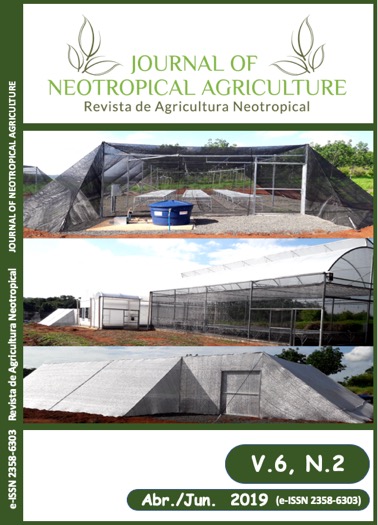ASPECTOS CULTURAIS, MORFOLÓGICOS E MORFOMÉTRICOS DE Sordaria fimicola INCIDENTE EM FOLHAS DE CAPIM-MASSAMBARÁ (Sorghum arundinaceum)
DOI:
https://doi.org/10.32404/rean.v6i2.1423Abstract
O capim-massambará (Sorghum arundinaceum) pode servir de fonte de inóculo de agentes de biocontrole como Sordaria spp. O objetivo deste trabalho foi avaliar o crescimento in vitro, a patogenicidade, caracterizar e identificar um isolado de Sordaria sp. incidente em capim-massambará. Amostras de folhas apresentando sintomas foram submetidas a isolamento em meio de cultura. A partir deste foram aplicados os seguintes testes: a) teste fisiológico – análise do crescimento micelial em meio de cultura. b) teste biológico – discos de micélio e solução de ascósporos foram inoculados em folhas; e c) identificação – caracterização morfológica das estruturas reprodutivas. O maior crescimento micelial foi observado nos meios BDA e ST. O isolado em condições artificiais não reproduziu os sintomas iniciais. O isolado apresentou peritécio gregário, semi-imerso em meio de cultura, sub-globoso, com organização celular reticulada, de dimensões de 1946,3-(1351,0)-507,9 × 1131,4-(828,2)-415,17 µm, com ostíolo de 413,85-(257,8)-123,8 µm; asca cilíndrica à clavada, unitunicada, de 195,0-(167,8)-135,6 × 21,8-(16,8)-9,1 µm; ascósporos apresentaram 29,7-(22,6)-13,7 × 14,9-(10,9)-1,6 µm. Com base nas características morfológicas e morfométricas, o isolado foi identificado como sendo S. fimicola.
References
(I) Agrios, G.N., 1997. Plant pathology, fourth ed. Academic Press, St. Paul, USA, 606 p.
(II) Alexopoulos, C.J., Mims, C.W., 1979. Introductory mycology, Third ed., John Wiley, New York, USA, p. 632.
(III) Alfenas, A.C.A., Mafia, R.G., 2007. Métodos em fitopatologia. Editora UFV, Viçosa, 382 p.
(IV) Barnett, H.L., Lilly, V.G., 1947. The effects of biotin upon the formation and development of perithecia, asci, and ascospores by Sordaria fimicola. Ces: and the not. Ces: and the not. American Journal Botany, 34(4), 196-204.
(V) Basu, S., Bose, C., Ojha, N., Das, N., Das, J., Pal, M., Khurana, S., 2015. Evolution of bacterial and fungal growth media. Bioinformation, 11(4), 182-184.
(VI) Bergamin Filho, A., Kimati, H., Amorim, L., 1995. Manual de Fitopatologia: princípios e conceitos, terceira ed. Editora Agronômica Ceres Ltda, São Paulo, v.1, 919 p.
(VII) Blum, L.E.B., Cares, J.E., Uesugi, C.H., 2006. Fitopatologia o estudo das doenças de plantas, segunda ed. Otimismo, Brasília, Brasil, n. 2, 121 p.
(VIII) Brow, G.G., 1995 How do earthworms affect microfloral and faunal community diversity? Plant and Soil, 170(1), 209-231.
(IX) Carr, A.J.H., Olive, L.S., 1958. Genetics of Sordaria fimicola. American Journal Botany, 45(2), 142-150.
(X) Chandramohan, S., Charudattan, R., 2001. Control of seven grasses with a mixture of three fungal pathogens with restricted host ranges. Biological Control, 22(4), 246–255.
(XI) Chiang, M., Van Dyke, C.G., Chilton, W.S., 1989. Four foliar pathogenic fungi for controlling seedling Johnsongrass (Sorghum halepense). Weed Science, 37(6), 802-809.
(XII) Doguet, G., 1960. Morphologie, organogénie et evolution nucléaire de l’Epichloe typhina. La place des Clavicipitaceae dans la classification. Bulletin Society Mycological, 76(1), 171-203.
(XIII) Greis, H., 1938. Entwincklungschit on Sordaria fimicola (Rob). Botany Archieves, 38(1), 113-15.
(XIV) Greis, H., 1942. Mutations und Isolationversuche zur Beeinflussung des gescheletes von Sordaria fimicola (Rob). Zeitschrift Botany, 89(1), 341-353.
(XV) Hall, R., 1971. Effect of carbon-nitrogen ratios on production of perithecia by Sordaria fimicola. Canadian Journal of Microbiology, 17(1), 132-134.
(XVI) Ingold, C.T., 1956. The spore deposited of Daldinia. Transitions British Mycology Society, 39(1), 378-380.
(XVII) Ingold, C.T., Cox, V.J., 1955. Periodicity of spore disharge in Daldinia. Annuals Botany Nova Scotia, 19, 210-219.
(XVIII) Jeffers, S.N., Martin, S.B., 1986. Comparison of two media selective of Phytophthora and Pythium species. Plant Disease, 70, 1038-1043.
(XIX) Lorenzi, H., Matos, F.J.A., 2008. Plantas daninhas do Brasil, nativas e exóticas, quarta ed. Instituto Plantarum de Estudos da Flora Ltda., Nova Odessa, p. 640.
(XX) Ni, M., Feretzaki, M., Sun, S., Wang, X., Heitman, J., 2011. Sex in fungi. Annual Review Genetical, 45, 405-430.
(XXI) Olive, L.S., 1956. Genetics of Sordaria fimicola I. Ascospore color mutants. American Journal Botany, 43(1), 97-106.
(XXII) Panizzi, R.C., Fernandes, N.G., Camargo, M., 2005. Doenças do sorgo, in: Kimati, H., Amorim, L., Rezende, J.A.M., Bergamin Filho, A., Camargo, L.E.A., (Eds.), Manual de Fitopatologia. Editora Ceres, São Paulo, v. 2, pp. 597-606.
(XXIII) Ritchie, P., 1937. The morphology of the perithecium of Sordaria fimicola (Rob) Ces. and the not. Journal Elisha Mitchell Scientific Society, 53(2), 334-342.
(XXIV) Tortora, J.G., Funke, B.R., Case, C.L., 2000. Microbiologia, sexta ed. Artmed, Porto Alegre, 920 p.
(XXV) Zhang, W.M., Moody, K., Watson, A.K., 1996. Responses of Echinocloa species and rice (Oryza sativa) to indigenous pathogenic fungi. Plant Distribution, 80(9), 1053-1058.
(XXVI) Zhang, W.M., Watson, A.K., 1997. Effect of dew period and temperature on the ability of Exserohilum monoceras to cause seedling mortality of Echinocloa species. Plant Disease, 81(6), 629-634.
Downloads
Published
How to Cite
Issue
Section
License
The authors retain the rights to the manuscripts and, therefore, are free to share, copy, distribute, perform and publicly communicate the work under the following conditions:
Acknowledge work credits in the manner specified by the author or licensor (but not in a way that suggests that you have their support or that they support their use of their work).
REVISTA DE AGRICULTURA NEOTROPICAL (ISSN 2358-6303) is under license https://creativecommons.org/licenses/by/4.0/
The State University of Mato Grosso do Sul, Sustainable Development Center of Bolsão Sul-Mato-grossense (CEDESU), of the University Unit of Cassilândia (UUC), preserves the patrimonial rights (copyright) of the published works and favors and allows their reuse under the license as mentioned above.
------------
The journal reserves the right to make normative, orthographic, and grammatical alterations in the originals, to maintain the cult standard of the language, respecting, however, the style of the authors.
Final proofs will be sent to the authors.
Published works become the property of the journal. The opinions expressed by the authors of the manuscripts are their sole responsibility.

